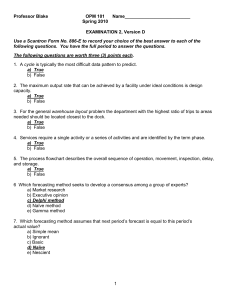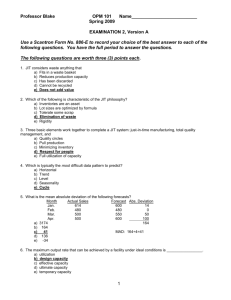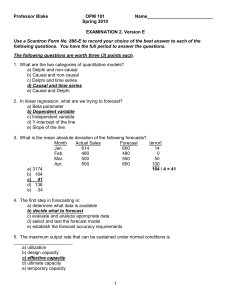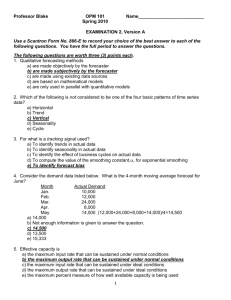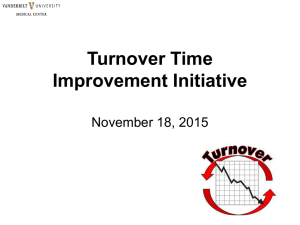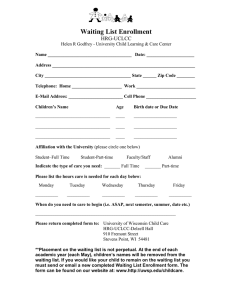version C
advertisement
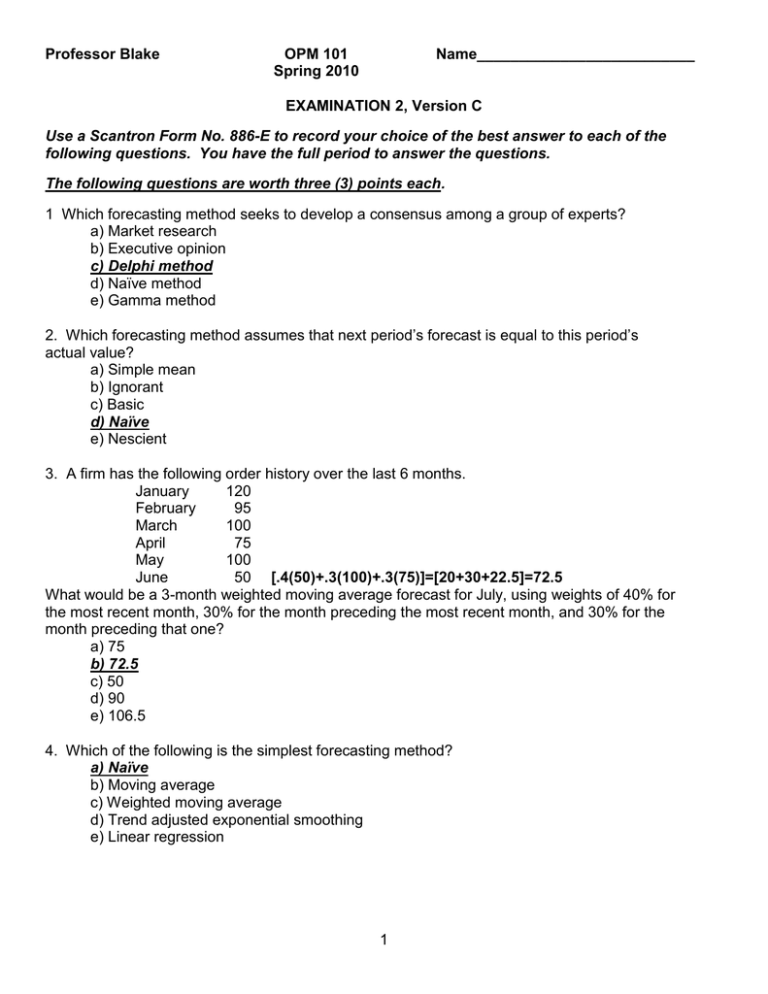
Professor Blake OPM 101 Spring 2010 Name__________________________ EXAMINATION 2, Version C Use a Scantron Form No. 886-E to record your choice of the best answer to each of the following questions. You have the full period to answer the questions. The following questions are worth three (3) points each. 1 Which forecasting method seeks to develop a consensus among a group of experts? a) Market research b) Executive opinion c) Delphi method d) Naïve method e) Gamma method 2. Which forecasting method assumes that next period’s forecast is equal to this period’s actual value? a) Simple mean b) Ignorant c) Basic d) Naïve e) Nescient 3. A firm has the following order history over the last 6 months. January 120 February 95 March 100 April 75 May 100 June 50 [.4(50)+.3(100)+.3(75)]=[20+30+22.5]=72.5 What would be a 3-month weighted moving average forecast for July, using weights of 40% for the most recent month, 30% for the month preceding the most recent month, and 30% for the month preceding that one? a) 75 b) 72.5 c) 50 d) 90 e) 106.5 4. Which of the following is the simplest forecasting method? a) Naïve b) Moving average c) Weighted moving average d) Trend adjusted exponential smoothing e) Linear regression 1 Professor Blake OPM 101 Spring 2010 Name__________________________ 5. The maximum output rate that can be achieved by a facility under ideal conditions is _________________. a) utilization b) design capacity c) effective capacity d) ultimate capacity e) temporary capacity 6. Operating a facility close to its best operating level is clearly important because a) it reduces fixed cost b) it reduces overtime requirements c) of impact on costs d) of impact on employees bonuses e) it increases production 7. Which of the following has the least to do with location analysis? a) sources of transportation b) reduction in trade barriers c) information technology reducing need for proximity d) retail stores locating near each other e) automation of factories 8. With respect to globalization, which of the following would not be considered an important location consideration? a) vertical integration b) trade barriers c) culture d) language barriers e) foreign markets 9. The challenge in process layouts is to arrange resources to maximize _____ and minimize ____ a) movement, effectiveness b) effectiveness, efficiency c) efficiency, waste of movement d) efficiency, effectiveness e) efficiency, labor cost 10. A company with a pure intermittent processing system is most likely to use which layout type? a) inverted b) hybrid c) process d) fixed position e) product 11. Bridge construction is an example of which layout type? a) inverted b) hybrid c) process d) fixed position e) product 2 Professor Blake OPM 101 Spring 2010 Name__________________________ 12. On which key tradeoff does the textbook focus concerning office layouts? a) cost vs. comfort b) pictures vs. windows c) cubes vs. doors d) network printers vs. individual printers e) proximity vs. privacy 13. What occurs when a customer enters a waiting line but decides to exit before being served? a) balking b) walking c) reneging d) vacillating e) jockeying 14. When calculating waiting line metrics you must ensure that the arrival rate and service rate are: a) for the same day. b) for the same probability. c) for the same site. d) for the same time period. e) for the same utilization factor. 15. Which of the following is not considered to be a valid performance measure of a waiting line system? a) the average number of customers waiting in line b) the average number of customers in the system c) the average amount of time customers spend waiting d) the arrival pattern e) the system utilization rate 16. Which of the following is not an assumption of the waiting line models presented in the textbook? a) the customers are patient b) customers come from an infinite population c) customer arrival rate is described by a Poisson distribution d) service times are described by an exponential distribution e) the waiting line priority rule is quickest service requirements first 17. Which of the following most closely describes job enrichment? a) vertical expansion b) transferring workers through a series of jobs to increase their scope of experience c) increasing the amount of workspace assigned to a worker d) horizontal expansion e) assigning two jobs to the same worker 18. What does work measurement determine? a) how long it should take to do a job b) what is the best way to do a job c) who is the best worker d) where work should be done e) why a particular step must be included in an operation 3 Professor Blake OPM 101 Spring 2010 Name__________________________ 19. For each work element in the time study, multiplying the mean observed time by the performance rating factor by the frequency of occurrence results in what? a) the normal time for the element b) the average observed time for the element c) the standard time for the element d) the average delay for the element e) the standard time for the job 20. A cycle is typically the most difficult data pattern to predict. a) True b) False 21. The maximum output rate that can be achieved by a facility under ideal conditions is design capacity. a) True b) False 22. For the general warehouse layout problem the department with the highest ratio of trips to areas needed should be located closest to the dock. a) True b) False 23. Services require a single activity or a series of activities and are identified by the term phase. a) True b) False 24. The process flowchart describes the overall sequence of operation, movement, inspection, delay, and storage. a) True b) False The following problems are worth ten (10) points each. 1. The Freewheel motorcycle dealer in the Chicago area wants to be able to forecast accurately the demand for the Freewheel Super Z12 motorcycle. From sales records, the dealer has accumulated the following data for the second half of 2000. Month Sales July 10 August 15 September 23 October 44 November 54 December 36 a. Compute a 3-month moving average forecast of demand for January 2001. (44+54+36)/3 = 44.67 b) Compute a 5-month moving average forecast of demand for January 2001. (15+23+44+54+36) = 34.4 4 Professor Blake OPM 101 Spring 2010 Name__________________________ 2. Medco plans to open a new medical center and is looking for a suitable location. They have narrowed their choice down to three locations, on Oak, Elm, and Ash Streets. They have defined four factors and have assigned weights to these factors as follows: proximity to hospitals (40), customer parking (30), appearance (20), and ease of expansion (10). They then rated the three locations for the four factors, using a scale of one to five. Their ratings are as follows: Weight Location Factor Oak Elm Ash Proximity to hospitals 40 2 80 5 200 3 120 Customer parking 30 5 150 1 30 3 90 Appearance 20 4 80 2 40 5 100 Ease of expansion 10 3 30 4 40 1 10 100 340 310 320 (a) Calculate the scores for each location. OAK 340 ELM 310 ASH 320 (b) According to the model which location should they choose? Choose OAK as it has the highest score. 3. Consider a single-line, single-server waiting line system. Suppose that customers arrive according to a Poisson distribution at an average rate of 50 per hour, and the average (exponentially distributed) service time is 45 seconds per customer. What is the average time spent in the system (in minutes)? λ = 50 customers/hour μ = 80 customers/hour (3600 sec/hr)/(45 sec/customer) = 80 customers/hour W = 1/(μ – λ) = 1/(80-50) = 1/30 hour * 60 min/hour = 2 minutes 5
